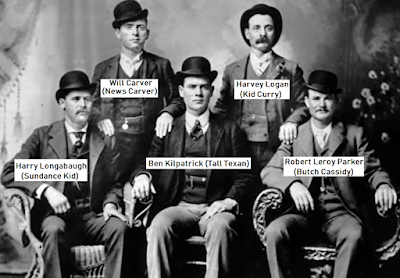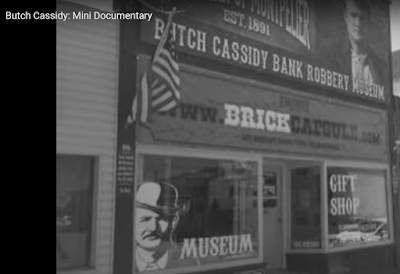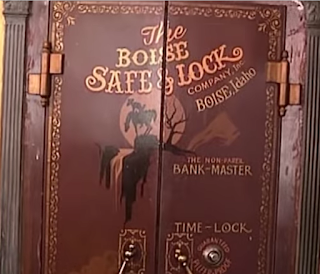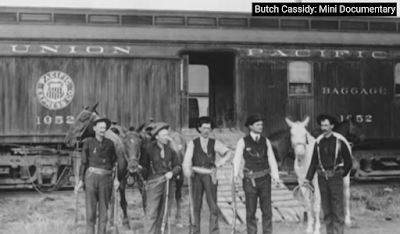This tragic event prompted a host of famous lawmen to go after the gang. It also prompted the Union Pacific Railroad to solicit the help of Charlie Siringo, a Pinkerton detective. Siringo’s mission was to apprehend Cassidy’s gang and bring them to justice.
As an aside, Butch Cassidy’s “Wild Bunch” was patterned after another gang that went by the same name. The original one, which was also known as the Dooling-Dalton gang, was formed on July 16, 1892, in Ingalls--an outlaw sanctuary--within the Oklahoma Territory. The original Wild Bunch came to an end on April 3, 1895, when they held up a Rock Island train at Dover, Oklahoma. Unable to crack open a safe presumed to hold $50,000, the gang robbed the passengers instead. The robbing and killing came to an end when Deputy U.S. Marshal Chris Madsen and his able pose caught up to the gang, killing several members.
Butch Cassidy And The Sundance Kid | #TBT Trailer | 20th Century FOX
“Of all the outlaw gangs produced by the American Old West (the gang was formed in the last decade of the 19th century), none met a more violent end than the Wild Bunch. Only two of its eleven members survived into the 20th century, and all eleven met violent deaths in gun battles with lawmen” (http://bit.ly/2OgGoa9).
The new Wild Bunch, which was formed after Cassidy’s release from prison in 1896, was made up of friends and associates. Included were George “Flat Nose” Curry, Ben Kilopatrick, William Ellsworth “Elzy” Lay, Will “News” Carver, Harvey “Kid Curry” Logan, Laura Bullion, and Harry Tracy. It was after the Montpelier, Idaho bank job that Cassidy brought Harry Alonzo Longabaugh, AKA: the Sundance Kid, into the picture. Incidentally, “News” Curry got his name because he enjoyed reading about himself in newspapers, or so it was said.
Cassidy’s Request for Amnesty
The criminal activities of the Wild Bunch did not stop with the Union Pacific’s Overland Flyer passenger train. On July 11, 1899, when they robbed a Colorado and Southern Railroad train near the town of Folsom, NM, Elzy Lay killed Sheriff Ed Farr and Henry Love. Unfortunately this led to his eventual conviction and a life sentence, which he served in the New Mexico State Penitentiary.
Things were heating up for the Wild Bunch.
It was in 1899, when Butch Cassidy approached Utah Governor Huber Wells concerning the negotiation of conditions surrounding the gang’s amnesty. Evidently an agreement ensued between Cassidy and E.H. Harriman, chairman of the Union Pacific Railroad. However, the Wild Bunch violated that agreement when they robbed another Union Pacific train in the Tipton, Wyoming area. This single act ended any hope for amnesty.
Five members of the gang met in Fort Worth, Texas, on December of 1900, where they had a group picture taken, which has since come to be known as the “Fort Worth Five” photograph. Unfortunately the Pinkerton Detective Agency discovered and used it to create wanted posters for Cassidy, Sundance, Kilpatrick, Logan, and Carver.
Things from that point appear to have gone downhill relatively fast.
- April 17, 1900: George Curry was killed in a shootout in Grand County, Utah.
- July 3, 1901: Kid Curry and others robbed a Great Northern train in Wagner, Montana, and a pose, led by Sheriff Elijah Briant, killed News Carver.
- December 12, 1901: Kilpatrick and Laura Bullion were captured.
- December 13, 1901: Curry killed two policemen in Knoxville during another shootout, although he was able to escape.
- July 26, 1901: Kid Curry returned to Montana where he killed James Winters, a local rancher, in cold blood. Winters apparently killed his brother, John, some years earlier.
As they say, “All good things must come to an end.” They also say, “It’s hard to change a leopard's spots,” and so once a hombre, always a hombre. All this will make sense in a few minutes.
It was in 1890 that Butch Cassidy acquired a ranch outside of Dubois, Wyoming, near the famous outlaw stronghold called the “Hole-in-the-Wall.” There were other get-away's that Cassidy and other gang members used.
“The Wild Bunch would typically separate following a robbery and flee in different directions, later reuniting at a predetermined location such as the Hole-in-the-Wall hideout, Robbers Roost, or Fannie Porter's brothel in San Antonio, Texas” (http://bit.ly/2qaHQ5Z).
The authorities were now closing in on both Butch Cassidy and the Sundance Kid. Soon there would be no place to run, nowhere to hide. The photographer of the Fort Worth Five had, in fact, posted a print of the group on his storefront window. It wasn’t long afterward that a Pinkerton detective happened to recognize one of them as he just happened to walk by. Imagine his surprise.
Thanks to fate or just plain stupidity, every one of these five Wild Bunch member’s face was now made public to the world on wanted poster that was sure to eventually yield results. And so, both men knew when the get’n was good, and they did just that on February 20, 1901. Actually, Cassidy had invited the others in the gang to accompany him out of the country, but only Sundance and his wife, Etta Place, agreed to go.
The trio left the United States for Argentina on February 20th, from there they made their way to Bolivia. It was there that the three purchased a 15,000-acre ranch near Cholia, which is situated on the east bank of the Rio Blanco.
Once a Bandito, Always a Bandito
You would think that anyone who gained such wealth, and having barely escaped capture, would resolve to live the remainder of their lives in a peaceful, lawful manner, but not so with Cassidy and Sundance.
It didn’t take long until the two banditos to come out of hiding in Bolivia. On February 14, 1905, two individuals, fitting the description of Cassidy and Sundance, robbed the Banco de Tarapaca y Argentino located in Rio Gallegos, which was approximately 700 miles south of Cholila. Shortly thereafter the pair sold their 15,000-acre ranch, heading north to San Carlos de Bariloche. Here they boarded the Condor, a steamer, which was headed to Chile.
By the end of 1905, Cassidy, Sundance and a third man appeared in Argentina where, on December 19, 1905, they robbed the Banco de la Nacion Argentina, which was located in a town called Villa Mercedes. The trio then headed to Chile through Buenos Aires, Pampas, then over the Andes.
In June of 1906, Sundance Kid and his wife, Etta, returned to the United States. In San Francisco, Etta remained stateside while Sundance returned to Bolivia where Cassidy had taken a job guarding payroll at the Concordia Tin Mine located in the Andes. On the Sundance Kid’s return, he assumed a position with the same mining company, working with his partner, Butch Cassidy.
As the story goes, on November 3, 1908, Cassidy and Sundance made tracks to San Vicente after they stole the payroll belonging to the Aramayo Franke y Cia Silver Mine. According to official records, the two robbers, assumed to be Cassidy and Sundance, took a room in a boarding house owned by a man by the name of Bonifaacio Casasola.
It was Casasola who tipped off a nearby cavalry post, which promptly dispatched three soldiers to investigate. Evidently the men who were staying in the boarding house had arrived with a mule that bore the Aramayo Mine brand. The cavalry commander also notified local authorities which, on November 6, three days after the robbery took place, surrounded the boarding house.
According to the official record, the two men holed up in the house, again assumed to be Butch Cassidy and the Sundance Kid, provoked a gunfight by killing one of the soldiers and wounding a second. Then, early in the morning, during a moment of silence in between gun fire, a man began to scream, at which time a lone shot pierced the night. A few minutes later, there was a second shot, and the two men were presumed to be dead. According to the police report, both men were riddled with bullet holes, and it was surmised that one of the men had shot his partner in the forehead, then turning the gun on himself.
The conclusion of the local police investigation was that the two men in the boarding house were the same that robbed the mining company. The Bolivian officials, however, were unable to positively identify either man. Attempts were also made in recent years to locate the bodies and to conduct DNA testing, but either local authorities’ records were wrong, concerning the actual graves, or the men’s bodies in the graves exhumed did not match known DNA samples provided by the Parker and Longabaugh families.
And so we come to the end of another dusty, wagon-worn trail, or have we? The fact is, there’s a growing body of evidence that might indicate that both men survived their Bolivia excursion. Or perhaps they were not in San Vicente on that fateful day.
Be sure to ready part 1! Be sure to visit THE TV WESTERN AND MOVIE FAN PAGE on Facebook!
Be sure to visit THE TV WESTERN AND MOVIE FAN PAGE on Facebook!













 Union Pacific Railroad Enforcement
Union Pacific Railroad Enforcement



No comments:
Post a Comment
Thank you for your comment.